Share of voice—the percentage of the market that your brand owns compared to your competitors—is one of the determining factors in whether your company will grow or stagnate.
It’s been proven over and over in the B2B world.

That graph from LinkedIn tracks brands’ share of voice (SOV) over their share of market (SOM)—the percentage of an industry’s sales that your brand owns.
As you can see, when the SOV is greater than the SOM, brands grow. If SOV is less than SOM, brands falter.
So what’s a CMO to do with this all-important metric? In this blog, post we’ll answer two questions:
- How do you calculate your SOV and SOM so you have benchmarks to measure against?
- How can you increase your SOV?
Let’s get started!
Question 1: How do you calculate your SOV and SOM so you have benchmarks to measure against?
You can calculate your Share of Voice in a couple of ways, but for each one, you’ll need some data.
Related Reading: What Is Share of Voice and Why Is It Important?
First, you’ll need to gather numbers for:
- Your brand’s total advertising investment (for a year or a quarter)
- Your industry’s total advertising investment (for the same period of time)
- Your brand’s total mentions (you’ll need a social media listening tool and/or a PR analytics tool for this)
- Total mentions in your industry
You may need help from your analytics team, your PR team, your social media staff, and others to get all this information.
Once you have it, you’ll use one of these basic SOV equations.
How to calculate advertising/marketing Share of Voice:
(Your brand’s advertising / The total advertising in the market) *100 = your Share of Voice
How to calculate PR Share of Voice:
(Your brand’s mentions / total industry mentions)*100 = your Share of Voice
Once you’ve got those numbers, you have your SOV benchmarks, and you can start setting goals.
Now let’s move on to market share, or Share of Market.
To calculate SOM, you’ll need this data:
- Your total revenue over a year or quarter
- Total revenue in your industry over the same period
Then you’ll use this equation:
(Your brand’s revenue / Total industry revenue) x 100
There you have it! You now know your SOV and SOM, and you can start comparing them to see whether you’re on a growth trajectory or a stagnation/shrinking one.
Question 2: How can you increase your share of voice?
Regardless of where you are in terms of growth, increasing your SOV should always be part of your strategy.
For frontrunners or those who already control a large market share in their industry, adding an additional 10 points to SOV can equate to 1.4% growth in market share.
For challenger brands, or those that are still trying to move into the frontrunner space, the task is a bit harder—you need to create an SOV strategy that’s about 3.5 times as effective as the industry leader in order to increase your SOM.
It sounds daunting, but it can absolutely be done.
Here’s how.
Achieve Balanced Brand Resonance
The concept of balanced brand resonance is Zen’s powerful approach to achieving massive growth for brands. This strategy involves leveraging four key types of media to build a comprehensive and effective marketing presence:
Paid media: This includes advertisements, influencer marketing, PPC (pay-per-click) content, and other forms of paid promotion. In other words, coverage you purchase.
Shared media: This refers to anything you share online, whether it’s your brand’s own content or content you reshare on your brand’s accounts.
Earned media: This is what you would typically associate with public relations, such as when your brand is mentioned in an article or digital publication, when your CEO is interviewed on a podcast, and so on.
Owned media: This encompasses everything your company has full control over, like your website, blog, podcast, social posts, video streaming sessions, and more.
By optimizing your exposure across all these different areas, you create balanced brand resonance, resulting in real momentum for brands trying to increase their SOV. This omni-channel strategy ensures that your brand message reaches your audience through various channels, reinforcing your presence and authority in the market.
For example, you can use influencer marketing (a form of paid media) to build trust by associating your company with respected voices in your industry. Combine this with strategic PR efforts (earned media) to extend your brand’s reach and credibility. Meanwhile, maintain a strong presence on your own platforms (owned media) and actively engage in content sharing and community building (shared media).
This comprehensive approach not only increases your visibility but also helps in building trust with your audience. In the B2B world, where decision-makers are looking for reliable and authoritative partners, a well-executed balanced brand resonance strategy can significantly boost your SOV and, consequently, your market share.
Invest in Ongoing PR
B2B PR can have an outsized effect on your bottom line and your SOV. Why? Because reputation and trust matter even more for B2Bs than they do for B2Cs.
Getting your brand media mentions, having your leadership team quoted in major outlets, earning a column in an industry journal—all these things build trust in your company and your people, and they get your name in front of a whole new audience. That trust and awareness are what help push your company to the front of your industry.
The more those prospects see your brand’s name, the more likely it is that they’ll think of you before your competitors the next time they’re looking for the product you sell.
Improve Your SEO
By improving your website’s SEO, you’ll make it a lot easier for customers to come across your brand online. Why does this matter? Research shows that buyers are up to 70% through their buying journey before they contact sales. So when customers are investigating solutions that might be the perfect fit, you want to ensure your brand shows up whenever they search with relevant keywords.
There are many ways to go about this, from a full-scale, outsourced SEO audit to tackling small pieces at a time when your team is able to.
But there are a few guidelines that you should follow regardless of your approach.
First, make sure you’re targeting the right keywords. What are your customers searching? Then, what are they clicking on? You can use a tool like Google Ads to figure out which keywords you need to focus on.
Creating valuable content is another often overlooked factor in improving your site’s SEO. By creating and publishing fresh, original, and engaging content on your website regularly, you can improve your search rankings over time.
Finally, you can augment your content and SEO strategy by implementing a paid ads campaign. These ads can take people to your most popular product or service pages, to your most high-performing content, or to landing pages where they can download your whitepapers or reports in exchange for an email address.
Increasing your SOV should be a priority for every B2B brand out there, especially those that are still working their way toward becoming industry leaders. Want our team to get you started? Let’s talk.





